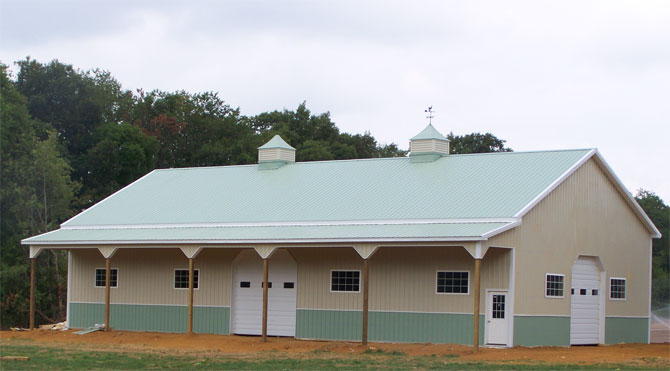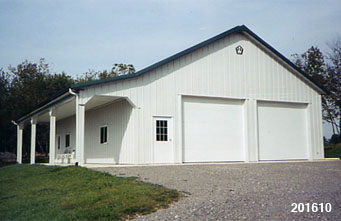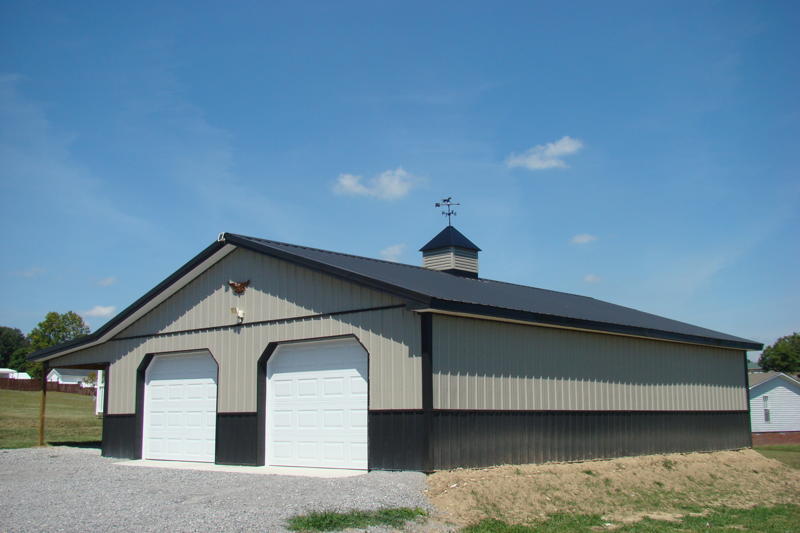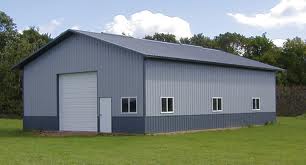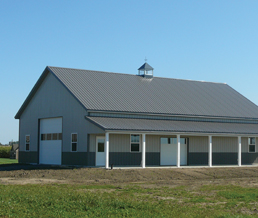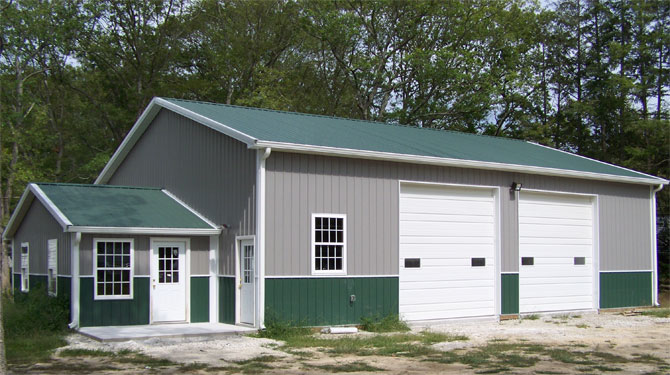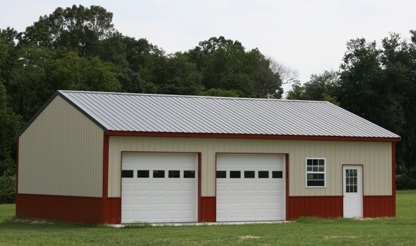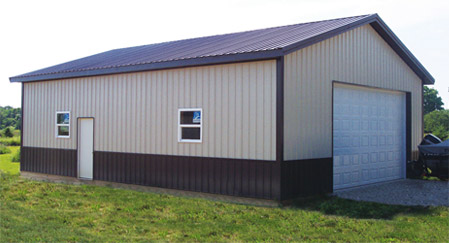US Metal Garages
Pole Barn Kits Arkansas | Pole Buildings Arkansas AR
We now carry Arkansas AR pole barn kits. We carry Arkansas AR pole buildings in many different sizes. Our metal pole barns come standard with 14 ga framing with available 12 gauge at an additional cost! Also our sheet metal comes standard with 29 gauge with 26 gauge available at an additional cost. Our sheeting is available in 13 different colors. Our Arkansas AR pole barns are great for agricultural, commercial and livestock! Our all toll free 1-877-662-9060 for more information!
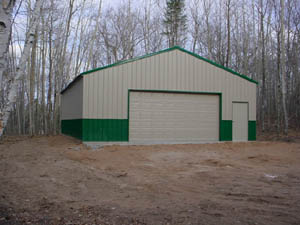
Call toll free: 1-877-662-9060
Email us: sales@mayberrymetalstructures.com
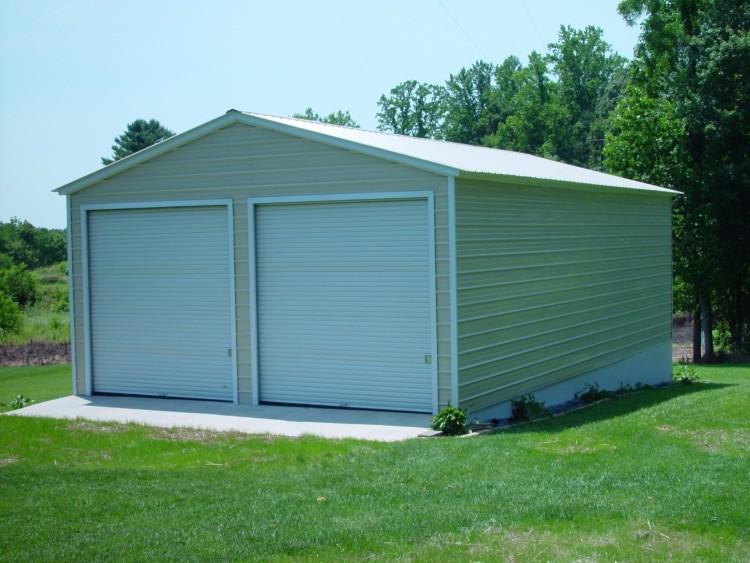
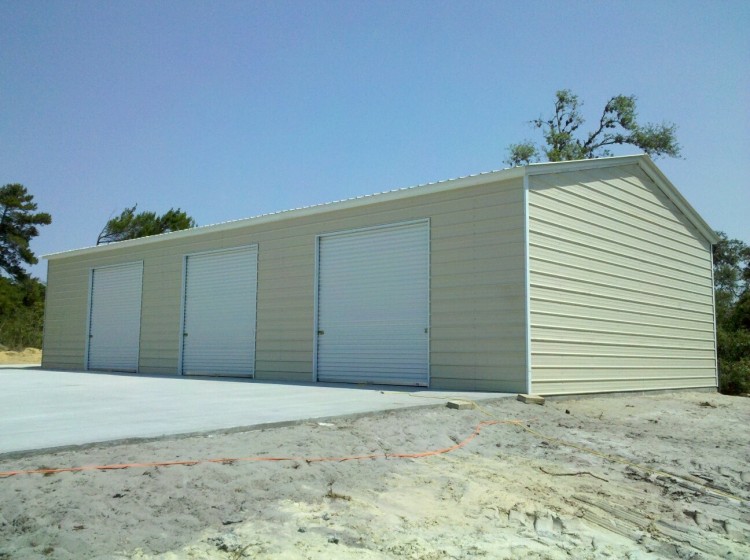
24x40x11 Vertical Roof Garage
With: (3) 10'x10' Garage Doors
(1) 36"x80" Walk in Door
24x30x11 Vertical Roof Garage
With: (2) 10'x10' Garage Doors
(1) 36" Walk in Door
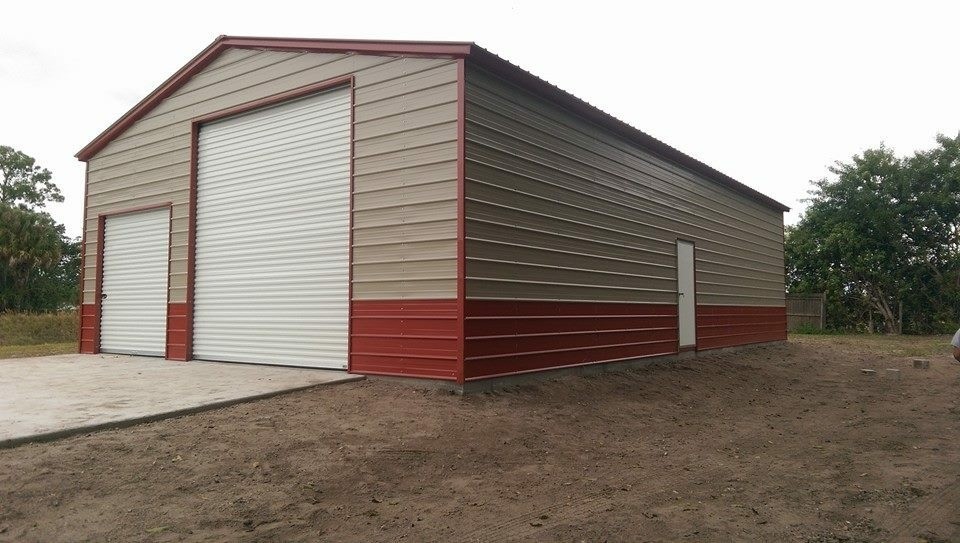
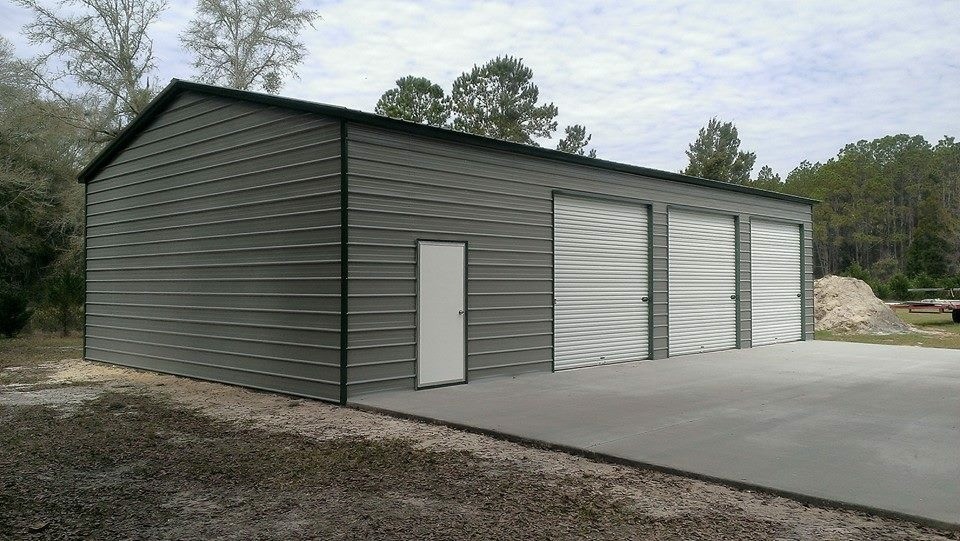
1-877-662-9060
24x45x12 Vertical Roof Garage
with: (3) 10'x10' Garage Doors
(1) 36" Walk in Door
24x40x12 Vertical Roof Garage
with: (1) 10'x10' Garage Door
(1) 6'x6' Garage Door
(1) 36" Walk in Door
1-877-662-9060
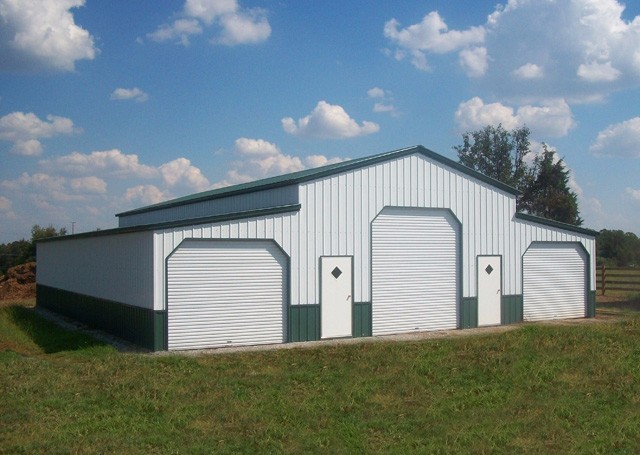
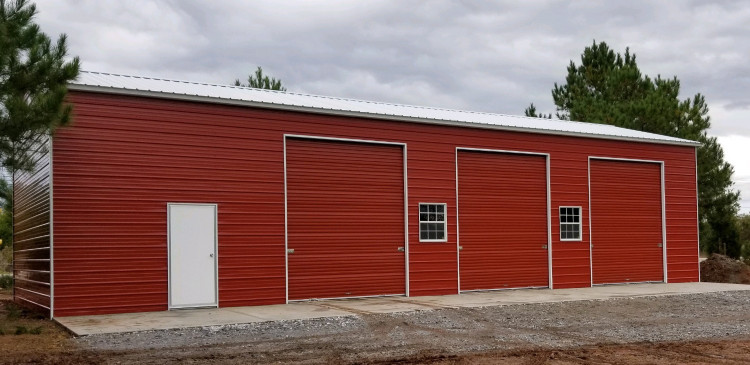
48x40x14&10 All Vertical Carolina Barn
12 & 24 & 12
30x50x12 Vertical Roof Garage
with: (3) 10'x10' Garage Doors
(1) 36"x80" Walk in Door
(2) Windows
1-877-662-9060
We sell to most of Arkansas including the following cities:
Alma AR, Altheimer AR, Arkadelphia AR, Ashdown AR, Ash Flat AR, Atkins AR, Augusta AR, Bald Knob AR, Barling AR, Batesville AR, Bay AR, Bearden AR, Beebe AR, Bella Vista AR, Benton AR, Bentonville AR, Berryville AR, Blytheville AR, Bono AR, Booneville AR, Brinkley AR, Brookland AR, Bryant AR, Bull Shoals AR, Cabot AR, Calico Rock AR, Camden AR, Caraway AR, Carlisle AR, Cave City AR, Cave Springs AR, Cedarville AR, Charleston AR, Cherokee Village AR, Clarendon AR, Clarksville AR, Clinton AR, Coal Hill AR, Conway AR, Corning AR, Crossett AR, Danville AR, Dardanelle AR, De Bluff AR, De Queen AR, Decatur AR, Dermott AR, Des Arc AR, De Witt AR, Diaz AR, Dierks AR, Dover AR, Dumas AR, Earle AR, El Dorado AR, Elkins AR, England AR, Eudora AR, Eureka Springs AR, Fairfield Bay AR, Farmington AR, Fayetteville AR, Flippin AR, Fordyce AR, Foreman AR, Forrest City AR, Fort Smith AR, Gassville AR, Gentry AR, Glenwood AR, Gosnell AR, Gould AR, Gravette AR, Greenbrier AR, Green Forest AR, Greenwood AR, Gurdon AR, Hamburg AR, Hampton AR, Harrisburg AR, Harrison AR, Haskell AR, Hazen AR, Heber Springs AR, Helena AR, Hope AR, Horse Shoe Bend AR, Hot Springs AR, Hot Springs Village AR, Hoxie AR, Hughes AR, Huntsville AR, Jacksonville AR, Jonesboro AR, Judsonia AR, Kensett AR, Kibler AR, Lake City AR, Lake Hamilton AR, Lake Village AR, Lamar AR, Lavaca AR, Leachville AR, Lepaton AR, Lewisville AR, Little Rock AR, Lonoke AR, Lowell AR, Luxora AR, Magnolia AR, Malvern AR, Mammoth Spring AR, Manila AR, Mansfield AR, Marianna AR, Marion AR, Marked Tree AR, Marmaduke AR, Marshall AR, Marvell AR, Maumelle AR, Mayflower AR, McAlmont AR, McCrony AR, McGehee AR, Melbourne AR, Mena AR, Mineral Springs AR, Monette AR, Monticello AR, Morrilton AR, Mount Ida AR, Mountain Home AR, Mountain View AR, Mulberry AR, Murfreesboro AR, Nashville AR, Newark AR, Newport AR, North Crossett AR, North Little Rock AR, Ola AR, Ozark AR, Osceola AR, Paragould AR, Paris AR, Parkin AR, Pea Ridge AR, Perryville AR, Piggott AR, Pine Bluff AR, Pocahontas AR, Prairie Grove AR, Prescott AR, Rector AR, Redfield AR, Rison AR, Rogers AR, Russellville AR, Salem AR, Searcy AR, Shannon Hills AR, Sheridan AR, Sherwood AR, Siloam Springs AR, Smackover AR, Springdale AR, Stamps AR, Star City AR, Stephens AR, Stuttgart AR, Texarkana AR, Trumann AR, Tuckerman AR, Van Buren AR, Vilonia AR, Waldo AR, Waldron AR, Walnut Ridge AR, Ward AR, Warren AR, West Crossett AR, West Fork AR, West Helena AR, West Memphis AR, White Hall AR, Wrightsville AR, Wynne AR and Yellville AR!
The Ultimate Guide to Pole Barns in Arkansas: Unveiling the Secrets to Building Your Perfect Structure
Arkansas, with its diverse climate and specific building regulations, presents unique challenges when it comes to constructing pole barns. Our expert tips and insights will help you navigate through these challenges, ensuring you make informed decisions every step of the way. From selecting the right materials and foundation to optimizing space utilization and enhancing the energy efficiency of your pole barn, we leave no stone unturned in providing you with the knowledge you need to build your dream structure.
Whether you're a seasoned builder or a first-time DIY enthusiast, this guide is for you. So, grab a cup of coffee, sit back, and let's embark on this exciting journey of building the perfect pole barn in Arkansas!
Constructing a pole barn in Arkansas offers numerous advantages that make it an attractive option for various applications. One of the primary benefits is the versatility of these structures. Pole barns can be designed and customized to serve a wide range of purposes, from agricultural storage and workshops to garages and even residential spaces. This flexibility allows you to tailor the building to your specific needs, ensuring that it perfectly fits your requirements.
Another significant advantage of pole barns is their cost-effectiveness. Compared to traditional stick-built structures, pole barns are generally more affordable to construct, thanks to their simpler design and the use of fewer materials. This makes them an excellent choice for those looking to maximize their budget while still obtaining a durable and functional building. Additionally, the ease of construction and the ability to perform much of the work yourself, if desired, can further reduce the overall cost of the project.
The durability and longevity of pole barns are also noteworthy benefits. These structures are designed to withstand the unique weather conditions and environmental challenges found in Arkansas, such as high winds, heavy snowfall, and extreme temperature fluctuations. With proper maintenance and care, a well-constructed pole barn can serve you and your family or business for decades, providing a reliable and long-lasting solution to your storage, workshop, or agricultural needs.
When planning to build a pole barn in Arkansas, it's essential to carefully consider several key factors to ensure the success and longevity of your project. One of the primary considerations is the local climate and weather patterns. Arkansas is known for its diverse weather conditions, ranging from hot and humid summers to cold and snowy winters. Understanding the specific challenges posed by the local climate, such as wind loads, snow accumulation, and rainfall patterns, will help you design a pole barn that can withstand these environmental stresses.
Another crucial factor to consider is the intended use of your pole barn. Will it be used for agricultural purposes, such as storing farm equipment or housing livestock? Or will it serve as a workshop, a garage, or even a living space? Knowing the specific purpose of your pole barn will guide you in selecting the appropriate size, layout, and features to meet your needs. For instance, if you plan to use the pole barn for storing large machinery, you'll need to ensure that the structure can accommodate the necessary clearances and weight-bearing capacity.
Site selection is also a critical factor when building a pole barn in Arkansas. The location of your pole barn can have a significant impact on its functionality, accessibility, and compliance with local regulations. Consider factors such as the terrain, soil conditions, proximity to utilities, and any potential zoning or building restrictions in the area. Choosing the right location can maximize the efficiency and long-term viability of your pole barn project.
The Advantages of Arkansas Metal Pole Barns: A Complete Guide
The sturdy construction of Arkansas metal pole barns provides optimal protection against the elements, ensuring long-term reliability and resilience. Additionally, their open-span design allows for spacious interiors without the need for intrusive support beams. This feature makes them ideal for accommodating a wide range of activities and storage needs.
Whether you're considering a new building project or contemplating upgrading an existing structure, understanding the advantages of metal pole barns is essential for informed decision-making. Join us as we explore everything you need to know about these versatile and dependable constructions.
Metal pole barns from Arkansas, also known as post-frame buildings, are constructed using large poles or posts buried in the ground or secured to a concrete foundation. These sturdy poles support the roof and walls, creating a durable and reliable structure. The open-span design of metal pole barns eliminates the need for interior support walls or columns, providing a spacious and versatile interior space.
Metal pole barns can be customized to suit a wide range of needs, from agricultural storage and equestrian facilities to workshops, retail spaces, and residential housing. Their versatility and cost-effectiveness make them a popular choice for various applications.
Metal pole barns are distinguished by their simple yet effective construction, which prioritizes functionality and durability. This straightforward building method contributes to their affordability and ease of construction, making them an attractive option for many property owners.
Selecting the ideal location for your pole barn in Arkansas is a crucial step in the planning process. The site you choose can have a significant impact on the overall functionality, accessibility, and compliance of your structure. When evaluating potential locations, there are several key factors to consider.
First and foremost, assess the terrain and soil conditions of the site. Pole barns require a stable and level foundation, so it's essential to choose a location with suitable soil characteristics that can support the weight of the structure. Avoid areas with poor drainage or high water tables, as these can lead to structural issues over time.
Another important consideration is the proximity to utilities. Ideally, your pole barn should be situated in close proximity to existing power, water, and sewer lines, if available. This can simplify the installation process and reduce the overall cost of the project. Additionally, consider the accessibility of the site, ensuring that it can be easily reached by vehicles and equipment necessary for the construction and ongoing use of the pole barn.
Compliance with local zoning and building regulations is also a crucial factor when selecting the location for your pole barn. Research the applicable laws and regulations in your area, as they may dictate the minimum setbacks from property lines, the maximum height or size of the structure, and any other specific requirements. Choosing a site that aligns with these regulations can help streamline the permitting process and avoid potential conflicts down the line.
Designing your perfect pole barn in Arkansas requires careful consideration of various factors to ensure that the structure meets your specific needs and complies with local regulations. One of the first steps in the design process is to determine the overall size and layout of the pole barn. Consider the intended use of the space, the amount of storage or workspace required, and any future expansion plans you may have.
When it comes to the layout, think about the flow of traffic and the placement of doors, windows, and any interior walls or partitions. Efficient use of space is crucial, so plan the design to maximize the functionality of the pole barn. If you're using the structure for agricultural purposes, such as housing livestock or storing farm equipment, you'll need to ensure that the layout accommodates the necessary clearances and access points.
The architectural style of your pole barn is another important design element to consider. While pole barns are often associated with a utilitarian aesthetic, you can incorporate design elements that complement the surrounding landscape or your personal preferences. This can include the choice of siding materials, roof styles, and even the inclusion of decorative features or accents.
Energy efficiency is also a key consideration in the design of your pole barn. Factors such as insulation, ventilation, and the placement of windows and doors can significantly impact the temperature regulation and overall energy performance of the structure. By incorporating energy-efficient design elements, you can not only reduce your operating costs but also contribute to a more sustainable and environmentally friendly building.
Welcome to the ultimate guide to pole barns in Arkansas! Whether you plan to use it for agricultural purposes, as a workshop, or even as a storage space, building the perfect pole barn requires knowledge and careful planning. In this comprehensive guide, we'll unveil the secrets to creating your ideal structure that not only meets your needs but also stands the test of time.
Arkansas, with its diverse climate and specific building regulations, presents unique challenges when it comes to constructing pole barns. Our expert tips and insights will help you navigate through these challenges, ensuring you make informed decisions every step of the way. From selecting the right materials and foundation to optimizing space utilization and enhancing the energy efficiency of your pole barn, we leave no stone unturned in providing you with the knowledge you need to build your dream structure.
Whether you're a seasoned builder or a first-time DIY enthusiast, this guide is for you. So, grab a cup of coffee, sit back, and let's embark on this exciting journey of building the perfect pole barn in Arkansas!
Benefits of building a pole barn
Constructing a pole barn in Arkansas offers numerous advantages that make it an attractive option for various applications. One of the primary benefits is the versatility of these structures. Pole barns can be designed and customized to serve a wide range of purposes, from agricultural storage and workshops to garages and even residential spaces. This flexibility allows you to tailor the building to your specific needs, ensuring that it perfectly fits your requirements.
Another significant advantage of pole barns is their cost-effectiveness. Compared to traditional stick-built structures, pole barns are generally more affordable to construct, thanks to their simpler design and the use of fewer materials. This makes them an excellent choice for those looking to maximize their budget while still obtaining a durable and functional building. Additionally, the ease of construction and the ability to perform much of the work yourself, if desired, can further reduce the overall cost of the project.
The durability and longevity of pole barns are also noteworthy benefits. These structures are designed to withstand the unique weather conditions and environmental challenges found in Arkansas, such as high winds, heavy snowfall, and extreme temperature fluctuations. With proper maintenance and care, a well-constructed pole barn can serve you and your family or business for decades, providing a reliable and long-lasting solution to your storage, workshop, or agricultural needs.
Factors to consider before building a pole barn in Arkansas
When planning to build a pole barn in Arkansas, it's essential to carefully consider several key factors to ensure the success and longevity of your project. One of the primary considerations is the local climate and weather patterns. Arkansas is known for its diverse weather conditions, ranging from hot and humid summers to cold and snowy winters. Understanding the specific challenges posed by the local climate, such as wind loads, snow accumulation, and rainfall patterns, will help you design a pole barn that can withstand these environmental stresses.
Another crucial factor to consider is the intended use of your pole barn. Will it be used for agricultural purposes, such as storing farm equipment or housing livestock? Or will it serve as a workshop, a garage, or even a living space? Knowing the specific purpose of your pole barn will guide you in selecting the appropriate size, layout, and features to meet your needs. For instance, if you plan to use the pole barn for storing large machinery, you'll need to ensure that the structure can accommodate the necessary clearances and weight-bearing capacity.
Site selection is also a critical factor when building a pole barn in Arkansas. The location of your pole barn can have a significant impact on its functionality, accessibility, and compliance with local regulations. Consider factors such as the terrain, soil conditions, proximity to utilities, and any potential zoning or building restrictions in the area. Choosing the right location can maximize the efficiency and long-term viability of your pole barn project.
The Advantages of Arkansas Metal Pole Barns: A Complete Guide
When it comes to durable, cost-effective, and versatile structures, metal pole barns from Arkansas stand out as a top choice. From agricultural purposes to commercial and residential use, the advantages of metal pole barns are vast and varied. In this complete guide, we'll delve into the myriad benefits these structures offer, from their customizable designs to their energy efficiency and low maintenance requirements.
The sturdy construction of Arkansas metal pole barns provides optimal protection against the elements, ensuring long-term reliability and resilience. Additionally, their open-span design allows for spacious interiors without the need for intrusive support beams. This feature makes them ideal for accommodating a wide range of activities and storage needs.
Whether you're considering a new building project or contemplating upgrading an existing structure, understanding the advantages of metal pole barns is essential for informed decision-making. Join us as we explore everything you need to know about these versatile and dependable constructions.
Understanding metal pole barns from Arkansas
Metal pole barns from Arkansas, also known as post-frame buildings, are constructed using large poles or posts buried in the ground or secured to a concrete foundation. These sturdy poles support the roof and walls, creating a durable and reliable structure. The open-span design of metal pole barns eliminates the need for interior support walls or columns, providing a spacious and versatile interior space.
Metal pole barns can be customized to suit a wide range of needs, from agricultural storage and equestrian facilities to workshops, retail spaces, and residential housing. Their versatility and cost-effectiveness make them a popular choice for various applications.
Metal pole barns are distinguished by their simple yet effective construction, which prioritizes functionality and durability. This straightforward building method contributes to their affordability and ease of construction, making them an attractive option for many property owners.
Choosing the right location for your pole barn
Selecting the ideal location for your pole barn in Arkansas is a crucial step in the planning process. The site you choose can have a significant impact on the overall functionality, accessibility, and compliance of your structure. When evaluating potential locations, there are several key factors to consider.
First and foremost, assess the terrain and soil conditions of the site. Pole barns require a stable and level foundation, so it's essential to choose a location with suitable soil characteristics that can support the weight of the structure. Avoid areas with poor drainage or high water tables, as these can lead to structural issues over time.
Another important consideration is the proximity to utilities. Ideally, your pole barn should be situated in close proximity to existing power, water, and sewer lines, if available. This can simplify the installation process and reduce the overall cost of the project. Additionally, consider the accessibility of the site, ensuring that it can be easily reached by vehicles and equipment necessary for the construction and ongoing use of the pole barn.
Compliance with local zoning and building regulations is also a crucial factor when selecting the location for your pole barn. Research the applicable laws and regulations in your area, as they may dictate the minimum setbacks from property lines, the maximum height or size of the structure, and any other specific requirements. Choosing a site that aligns with these regulations can help streamline the permitting process and avoid potential conflicts down the line.
Designing your perfect pole barn
Designing your perfect pole barn in Arkansas requires careful consideration of various factors to ensure that the structure meets your specific needs and complies with local regulations. One of the first steps in the design process is to determine the overall size and layout of the pole barn. Consider the intended use of the space, the amount of storage or workspace required, and any future expansion plans you may have.
When it comes to the layout, think about the flow of traffic and the placement of doors, windows, and any interior walls or partitions. Efficient use of space is crucial, so plan the design to maximize the functionality of the pole barn. If you're using the structure for agricultural purposes, such as housing livestock or storing farm equipment, you'll need to ensure that the layout accommodates the necessary clearances and access points.
The architectural style of your pole barn is another important design element to consider. While pole barns are often associated with a utilitarian aesthetic, you can incorporate design elements that complement the surrounding landscape or your personal preferences. This can include the choice of siding materials, roof styles, and even the inclusion of decorative features or accents.
Energy efficiency is also a key consideration in the design of your pole barn. Factors such as insulation, ventilation, and the placement of windows and doors can significantly impact the temperature regulation and overall energy performance of the structure. By incorporating energy-efficient design elements, you can not only reduce your operating costs but also contribute to a more sustainable and environmentally friendly building.

